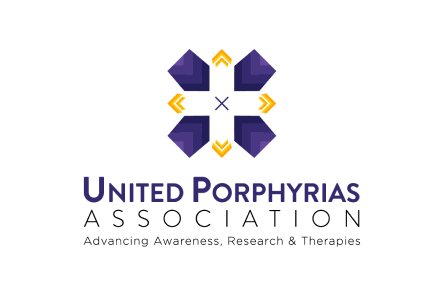United Porphyrias Association
Cycle 3
The porphyrias are a group of rare, genetic disorders. ach type of porphyria is caused by a defect in a specific enzyme in the heme biosynthetic pathway. Without these enzymes working properly, the body is not able to finish making heme and it causes a buildup of other compounds, called porphyrins. Types of porphyrias include acute hepatic porphyrias and cutaneous porphyrias.
Last updated 04/30/2025
Clinical
Disease Class
Inherited metabolic disorder
Body Systems
Metabolic
Organs
Blood
Bone marrow
Brain
Kidneys
Liver
Muscles
Nerves
Skin
Stomach
Known Genetic Link
Yes, one or more genes directly cause the condition
causative_genes
ALAD
ALAS1
CPOX
FECH
HMBS
PPOX
UROD
UROS
contributory_genes
None specified / unknown
Type of Inheritance
Autosomal dominant
Autosomal recessive
De novo
Mitochondrial
X-linked dominant
X-linked recessive
Newborn Screening
No
Disease Mechanism(s)
Enzyme deficiency
Inherited metabolic disorder
Transport defect
Age of Onset
Adolescence (12-17)
Adulthood (age 18-64)
Early childhood (age 1+-5)
Infancy (age 0-1)
Prebirth
Average Age at Diagnosis
Adolescence (12-17)
Adulthood (age 18-64)
Early childhood (age 1+-5)
Infancy (age 0-1)
Pre-Birth
Life Expectancy
Adulthood (age 18-64)
Elderly (age 65+)
Infancy (age 0-1)
Affected Sex(es)
Female
Intersex
Male
National Prevalence
1001-10000
Global Prevalence
10000+
National Incidence
51-100
Global Incidence
101-1000
Populations and/or ancestry with higher prevalence
Yes, there is a founder effect of different porphyrias - this varies per type.
Symptoms / Phenotypes
abnormal blistering of the skin
abnormality of skin pigmentation
anemia
anxiety
atypical scarring of skin
bone break / fracture
bone deformations
cardiac abnormalities
cognitive impairment / confusion / brain fog
constipation
cutaneous photosensitivity
dark urine
depression
diarrhea
fragile skin
hallucinations
hypertension
hypertrichosis
liver disease
neuropathic pain
pain, abdominal
peripheral neuropathy
thickened skin
vomiting / nausea
Biomarkers
Diagnostic
· porphobiliniogen;aminolevulinic acid;protoporphyrin
Monitoring
· porphobiliniogen;aminolevulinic acid;protoporphyrin; urine porphyrins
Therapeutic
· porphobiliniogen;aminolevulinic acid;protoporphyrin
Existing Therapies
Complementary and Alternative treatments
· hydroxychloriquine; cimetidine; phlebotomy
FDA-Approved for Symptom Relief
· Scenesse; Panhematin; Givlaari
Organizational & Research
Cell Lines
None
Cell Lines, Institution
None
Cell Lines, share
N/A
Disease Model
None
Disease Model, share
N/A
Clinical Trial Role
Data analysis
Data sharing
Focus group
Funding
Meeting with regulators
Outcome measures, development
Recruitment and outreach, patients
Recruitment and outreach, trial sites/physicians
Results dissemination, publication
Study material design, review (not protocol)
Study protocol design, review
Travel coordination
Biobank, Institution
None
Center of Excellence, Institution
Atrium Health Wake Forest North Carolina Baptist Hospital
Banner Health
Cleveland Clinic
Massachusetts General Hospital
Mt. Sinai
Thomas Jefferson University Hospital
UTHealth Houston (The University of Texas Health Science Center at Houston)
University of Alabama
University of California San Francisco (UCSF)
University of Illinois Chicago
University of Kentucky
University of Miami
University of Minnesota
University of Missouri
University of Pittsburgh
University of Texas Medical Branch at Galveston
University of Utah
University of Washington
Center of Excellence, Involvement
Consulted
Designed
Funded
Registry
Yes, we have collaborated on a registry
Data Collected, Registry
Clinical data
Genetic data
Longitudinal natural history data
Medication usage
Patient contact info
Patient-reported data
Data Entered by, Registry
Clinicians
Platform, Registry
REDCap
Natural History Study
Yes, we have collaborated on a natural history study
Data Collected, Natural History Study
Clinical endpoints (outcomes)
Genetic data
Medication usage
Patient-reported outcomes
Retrospective data
Platform, Natural History Study
REDCap
FDA Patient Listening Session
Yes
FDA Patient-Focused Drug Development (PFDD) Program
Yes
ICD Codes
We use an ICD-10 code capturing the family of diseases to which our disease belongs
We use an ICD-11 code capturing the family of diseases to which our disease belongs
Yes, we have an ICD-10 code specific to our exact disease
Yes, we have an ICD-11 code specific to our exact disease
Diagnostic Guidelines
Yes, we have guidance available on our website
Yes, we have published formal guidelines in a peer-reviewed journal
Science Advisory Board Policies
No policies
Research Network Policies
Has CRN but no policies
Research Roadmap
We don't have a Research Roadmap
International Chapters
None
International Partners
Africa
Asia
Europe
North America
South America
